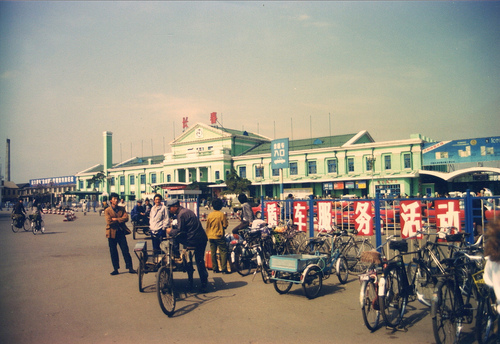When I was living in Changchun in the 1990s, as the city was beginning to shed the past and put on a modern skin, I often wondered what it would look like twenty years hence. This video answers the question. (Note: All the tall buildings you see were built during my time there or after I left in 1998.)
For those of you who live in Changchun or are familiar with the city today, you’ll appreciate this picture from my collection of the Changchun train station in 1990.

Changchun is the capital of Jilin province, in China’s northeast (dongbei) region. The population is 7.6 million, with 3.8 million living in the urban core. The name of the city means “long spring” which is a bit of a misnomer, given its long harsh winters. In other parts of the country a common greeting is “have you eaten yet?” In Changchun the common greeting is “leng bu leng?” Are you cold? Given that I am from Minnesota, it was a suitable work assignment for me!
Around China, the city has two main claims to fame (weather aside): universities and cars. There are 27 universities, including two which are considered national “key” universities. Northeast Normal University, where I studied Chinese is one of them. The country’s largest automobile manufacturer, First Auto Works, is based there. You know all those black Audis that you see on the streets of China? They are made in Changchun.
The history of the city is mostly tied up with the Japanese occupation. In 1932 Changchun (renamed to Xinjing— “New Capital”) became the capital of the Japanese puppet state of Manchukuo, what we know in English as Manchuria. They brought Puyi, the deposed Qing emperor to the city and installed him as the emperor of the new Manchu Empire. The city was liberated by the Soviet Red Amy in 1945 (the airplane on top of that monument commemorates that event), remaining there until the Nationalist forces arrived in 1946. The People’s Liberation Army took the city in 1948, following a siege that left hundreds of thousands dead.
Christianity came to Changchun in the 1890s with the arrival of Irish Presbyterian missionaries, who established what is today the largest church in town, the Changchun Christian Church. I have special memories of attending a Christmas Day service with my sister and her family when they visited me in 1997.
The most famous western missionary associated with this region is Jonathan Goforth, who made several trips to the region for evangelistic preaching events in 1906 and 1908. In the 1920s the Catholics established a mission in Changchun, with Auguste Ernest Gaspais as bishop.
Changchun is a great place to study Chinese since Putonghua (“standard” dialect) is the one commonly spoken. In other words, what you learn in the classroom is pretty much what you hear on the streets, something that is not the case everywhere in China. To be sure there is a local dialect, but clear Putonghua is widely spoken.
Travel to and from the city is quite easy. It’s a 6-hour bullet train ride from Beijing (it was a 15-hour trip when I lived there). There are also direct international flights to and from Pyongyang, Seoul, Singapore, Tokyo, Vladivostok, Taipei, and Bangkok.
If you want more in-depth knowledge of the history of the city, I highly recommend Micheal Meyer’s book Manchuria: A Village Called Wasteland and the Transformation of Rural China.
If your China travels ever find you in the Northeast, be sure to visit Changchun!
More resources on Changchun:
- Changchun Travel Guide (China Travel Guide)
- Top 10 attractions in Changchun, China (china.org.cn)
Header image credit: Changchun, China, by 李 哲宇, via Flickr.
Text image credit: Joann Pittman.

Joann Pittman
Joann Pittman is Vice President of Partnership and China Engagement and editor of ZGBriefs. Prior to joining ChinaSource, Joann spent 28 years working in China, as an English teacher, language student, program director, and cross-cultural trainer for organizations and businesses engaged in China. She has also taught Chinese at the University …View Full Bio
Are you enjoying a cup of good coffee or fragrant tea while reading the latest ChinaSource post? Consider donating the cost of that “cuppa” to support our content so we can continue to serve you with the latest on Christianity in China.